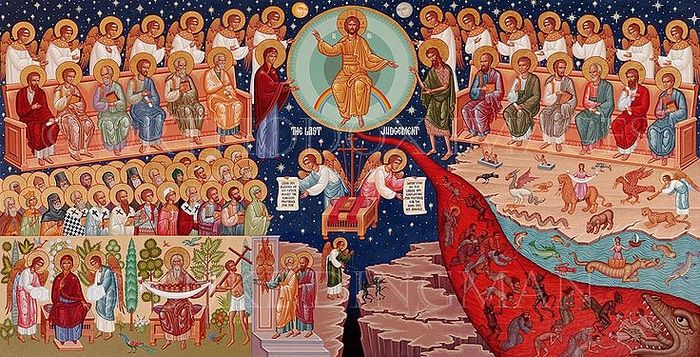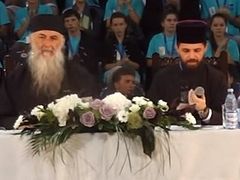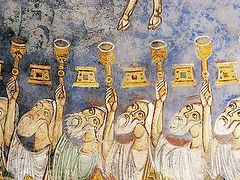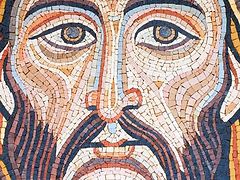Source: Apologia Pro Ortho Doxa
May 18, 2016
1. I think we need to avoid simply noting that there were statues of cherubim in the Inner Sanctuary of the Temple and the Most Holy of the Tabernacle. This seems to me to flatten out covenant history, making it appear as if icons were always fine, which is against the argument of St. John Damascene, who argues that it was specifically the Incarnation which made it fine.
2. The Ten Words of Exodus 20 correspond to the Ten Creative Words of Genesis 1. The firmament is the mediating boundary between the Heaven of God and our material cosmos (I have an article discussing the role of the firmament in the Bible, if you’d like), and the corresponding commandment is the command to not make graven images. In terms of the furniture of the tabernacle, the firmament is the veil which bounds the Holy of Holies from the Holy Place. That’s a very important point, because it’s only in the Holy of Holies that we see personal iconography
3. God declares in Deuteronomy 5 that Israel is not allowed to make iconography because “you saw no form.” In the Old Testament, the divine glory is concealed in a deep darkness. They hear a voice, but do not see a form. Hearing is protological, seeing is eschatological. This theme gets taken up in the Gospel of John, where the Second Word pops up again and again. Jesus says to the Jews “You have neither heard his voice nor seen his form.” Wicked Israel is not considered part of the Sinai generation who did hear God’s voice. But He says to the Apostles “if you have seen me, you have seen the Father.” The commandment to build and worship at a single central sanctuary begins the Second Word section of Deuteronomy (which follows out the Ten Commandments) in Deuteronomy 12, so Jesus in John 4 notes the transfiguration of this command because of His own Incarnation. “The hour is coming and is already hear, when you will neither worship at this mountain, or in Jerusalem.”
4. The reason for all of this is because of John’s use of tabernacle symbolism. We know that the “Logos became flesh and tabernacled among us.” Interestingly, “Nadir” in Hebrew refers to both a “Word” and the Inner Sanctuary of the Temple in the book of Kings. The Holy of Holies has become flesh and tabernacled among us. And it is only in the Holy of Holies that we see any imagery. We’re told that Jesus has “angels ascending and descending upon Him” which comes from Jacob’s Ladder in Genesis 28. Jesus is the true ladder to heaven, who permanently links up Heaven and Earth, looking towards the day when Heaven and Earth will be fully married. We symbolize God visually because eschatological sight has been realized.
5. Paul also makes this point in 2 Corinthians 3. Israel in the flesh, enslaved to the old covenant, hears the book. Israel in the Spirit (the Church), free in the new covenant, sees the glory of God in the face of Jesus the Messiah. Hearing is the old covenant, hearing+sight is the new covenant.
5. This is related to what Paul says about the mystery of the kingdom. Throughout the Old Testament, the mystery of the kingdom was locked up in the Holy of Holies. There was life in the Manna, rule in Aaron’s Rod, the inscription of Torah on the heart in the Stone Commandments, and the gift of sight in the Divine Glory and the cherubim. But now, in and through the Incarnation, the mystery of the kingdom has been published.
6. This argues pretty decisively that one can symbolize Christ in visual form. What about the Saints? In order to understand this, one needs to grasp what the cherubim in the Temple symbolized. Contrary to popular understanding, they did not correspond to the cherubim who guarded Eden. The Garden of Eden matches the Holy Place of the Tabernacle, not the Most Holy. In the Temple, these two guardians are symbolized by the pillars Jachin and Boaz outside the Holy Place. Instead, the two cherubim of the Tabernacle and the four of the Temple symbolize God’s heavenly council. We see this council of angels in session in Isaiah 6, Job 1-2, 1 Kings 22, and so on. But when Adam wishes to be “as gods”, that means he wants to be enthroned in God’s council. The demons are on God’s council, but God tells them in Psalm 82 that they will one day be cast out and “die like men” just as Adam wished to be “like gods” but died. Eye for eye, tooth for tooth.
This prophecy is fulfilled in Revelation 12, where Satan and the third of the star-angels who followed him are cast out of Heaven.
In the Temple, there are two cherubim standing next to God and two cherubim which hold up God’s throne. This is a three-tiered council, shown in more depth in Revelation. In Revelation 4-5, we see the throne of God the Holy Trinity, with thunder (Father), Voices (Son), and lighting (Spirit). Surrounding God is an emerald rainbow- emerald is the color of Levi, symbolizing the twenty-four angelic elders who constitute the rainbow as the 24 chief priests set up by David in the Temple. But it’s also jasper and carnelian, the colors of Judah and Benjamin, the two royal tribes- and since Judah is the firstborn (elevated to that position after the fall of his three older brothers) and Benjamin is the lastborn, this symbolizes the heavenly council as the summation of humanity from A-Z. Below God’s throne are four living creatures with twenty-four wings. In the OT, the number of the divine council is 72, and we see here two groups of twenty four- the other third are the demons, cast out of Heaven in Revelation 4-5.
That third tier uphold God’s throne- they are ministering spirits, the angels. But the emerald rainbow is the second tier, the “sons of God” who govern the world. Angels held those thrones until the time when humanity was ready (see Hebrews on this point), but in Revelation, they give these thrones to men- Revelation 20 has the “beheaded” taking the thrones in the “first resurrection.” The second death is the resurrection of the wicked, so the first resurrection, by implication, is the death of the righteous. They are “beheaded” because the 144k had their heads dedicated as Nazirites in Revelation 7. We are baptized into the Name of Jesus the Messiah, we take that Name on our forehead as a dedication, and when we die in Christ, our vow is completed and we enter into the first resurrection, sitting on thrones around Christ. We are the emerald-jasper-carnelian rainbow around God.
So:
1. The Holy of Holies was the only place which contained iconography of living beings in the Old Testament, because the Holy of Holies symbolized the Throne of God, and it was locked away in the Old Covenant- the High Priest went in once a year, and it was completely dark inside. Moreover, he himself was covered up by a cloud of incense.
2. Jesus is the Incarnate Holy of Holies, who builds a permament ladder to Heaven from the Throne of God to Earth, unlocking the Holy of Holies to us.
3. Sight is a feature of the new covenant, on account of the Incarnation. Hence, we symbolize the incarnate one visibly in order to point towards the realization of the eschatological age in Christ.
4. Moreover, since the Holy of Holies has been broken open, and since the two/four cherubim in the Holy of Holies symbolize the members of God’s council, we can symbolize the members of the heavenly council.
5. In Revelation, the Saints who have reposed in Christ are exalted to a position on God’s council - hence, we can symbolize them in iconography.





Shouldn't that be 'debir', not 'nadir'?
I don't think there is a word 'nadir' in hebrew, although a 'neder' is a <em>vow</em>.
On the other hand 'dabar' is the term for a word, an act, a thing, a matter, etc; and the 'debir' (presumably, 'oracle') is the sanctuary.